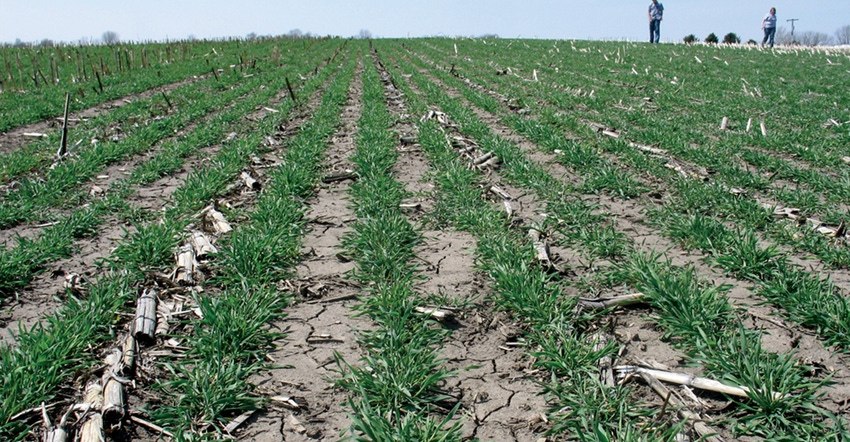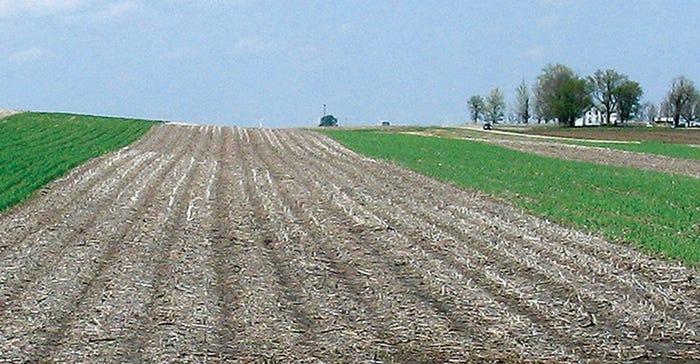April 21, 2020

Summing up 10 years of research, Iowa Learning Farms and Practical Farmers of Iowa recently published the final report from their 10-year field-scale study of the effects of winter rye cover crops on corn and soybean yields.
With consistent results across the full decade of recording and measurements, the final report notes no significant improvement or decline in cash crop yields attributable to the use of cover crops. The researchers may have been looking for more statistically substantial yield benefits, but in speaking with farmers who participated in the program, other practical benefits from cover crops were reported.
Cooperating farmers were asked to plant full-field-long strips with and without the cover crop to provide a valid comparison at field scale. The fields were all no-till in a soybean, corn rotation that had not been previously planted with cover crops. While some farmers dropped from the study in less than 10 years, none dropped because the cover crops weren’t delivering benefits. Some even noted that they dropped so they could convert the comparison strips to cover crops as well.
Rick Juchems of Plainfield in northeast Iowa says, “For the last few years, the study strips were the only parts of the fields where I didn’t have cover crops. I had committed to the study and stuck it out until last fall’s harvest, but I’m at 100% now.”
George and Steve Schaefer, farming near Kalona in southeast Iowa, dropped out of the study after six years because they changed the row direction in the field with the study strips. George Schaefer says they were not new to cover crops at the beginning of the study but glad they were able to take part.
“We had been PFI members for some time and thought we understood the benefits of cover crops, but what we knew then was minuscule compared to what we’ve learned through this and other studies by ILF and PFI,” he says.
The Schaefers plant cover crops on about 80% of their fields every year.
Benefits beyond yields
Asked about the benefits cover crops delivered over the course of the study, Rob Stout from West Chester in southeast Iowa points immediately to erosion control. “We’ve been no-tilling since 1983 and thought it would fix our erosion problems. But particularly since 2003, we’ve seen much stronger rainfall in the spring, and no-till just wasn’t getting the job done. Adding cover crops to our no-till fields virtually eliminated erosion.”
The Schaefer farm also saw erosion significantly reduced. “We experienced a flood in the field that had the test strips and saw real proof that cover crops held the soil and soybean residue in place,” Schaefer says. “The difference between the two strips made it easy for anyone to see the benefit.”

SIDE-BY-SIDE: The farmers maintained replicated strips running the entire length of a field. Each replication had one strip with cover crops and one without.

Improved soil health, water infiltration and higher biomass were also noted by the farmers. According to Stout, soil health has been measured to be better since he added cover crops. Other studies on his farm have shown more microbial activity, efficient decomposition and better water infiltration.
The Schaefers also reported that the amount of material being returned to the soil increases organic matter and supports nutrient needs of the cash crops.
Juchems provided a different example of soil health improvement. “My cover crop test strips went through an area that had been excavated, and the disturbance had rendered the area much less productive. I feel that the introduction of cover crops sped the rehabilitation of the disturbed soil by several years. The proof was in a return to normal plant health and size much sooner in the cover crop strips than the adjacent test strips.”
Learning along way
Other benefits included reduction of insecticide and herbicide needs, potential revenue from cover crop grazing, ability to get into fields earlier during a wet springtime and increased biodiversity.
Planting into cover crops was one area that required some learning and management changes. The study report noted that some of the early-year corn yields were affected by planter settings, which were adjusted in subsequent years.
Schaefer also reported they were able to disprove a common belief, “Farmers seemed certain that the rye would absorb the moisture from the soil, stealing the water needed by the corn to get established. We found that the rye did suck up the moisture to the point that we were able to get into the fields earlier, but there wasn’t any effect on the corn. It is a win-win scenario.”
Why isn’t everyone doing it?
It might be a silly question, but considering the benefits and proof that yields aren’t reduced, it’s frustrating to these farmers that more of their peers aren’t rushing to plant cover crops. Cost-share funds are available to cover much, if not all, of the startup costs, and the potential for financial gains are numerous.
For those looking to dip a toe in the water, Shaefer recommends trying cover crops before beans and using cost-share funds. “It’s a no-brainer if you own the land, and even if you are a tenant, you can use it as an opportunity to educate the landowner about improving the quality of their soil and production value of their land.”
Stout champions field days and other educational outreach to bring more farmers into the cover crop fold. “I’ve hosted and attended field days, and there is nothing more persuasive than showing another farmer the results, and sharing the challenges and successes we’ve experienced.”
Juchems has advocated with farmers in his area and has worked diligently to help many get started with cover crops. “It can be difficult to get some farmers to change, but when we can show tangible results and dispel inaccurate lore and perceptions, the task is much easier. As a state and industry, we need to step up and make cover crops the norm instead of the exception.”
Simply stated, cover crops are just a part of operating a farming business for these and other farmers in Iowa. Stout put it this way: “It’s part of my budget and it’s a part of the business, I don’t know why anyone is waiting to adopt cover crops.”
To see the cover crop report, visit ILF and PFI.
Ripley is an Iowa Learning Farms conservation outreach specialist.
About the Author(s)
You May Also Like




